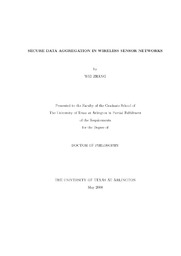| dc.description.abstract | Recent advances in micro-electro-mechanical systems (MEMS)
technology and wireless communications technologies have enabled the
deployment of wireless sensor networks (WSNs) in a plethora of
applications, ranging widely from military surveillance to civilian
applications. To protect the networks from different kinds of
attacks, security in wireless sensor networks plays a crucial role
and has received increased attention especially in the applications
deployed in hostile environments, such as battlefield monitoring and
home security. While extensive efforts have been devoted toward
securing conventional networks, the stringent resource constraints,
such as energy, communication and computation capability, etc., have
often prevented their direct adoptions.
As the goal of a sensor network is to gather sensory data from the
deployed sensor nodes, in-network processing, or aggregation, is
often adopted for energy efficiency. How to guarantee the security
of aggregation is an intriguing challenge. In this dissertation, we
propose a novel framework for secure data aggregation in WSNs, which
includes two approaches i) a watermark based approach for the
aggregation supportive authentication and ii) a trust model based
approach for securing data aggregation.
We first propose an end-to-end authentication scheme based on
digital watermarking, a proven technique notably in the multimedia
domain. The key idea is to visualize the sensory data gathered from
the whole network at a certain time snapshot as an image, in which
every sensor node is viewed as a pixel with its sensory reading
representing the pixel intensity. Under this mapping, the
authentication information is modulated as a watermark and
superposed on the sensory data at the sensor nodes. The watermarked
data then can be aggregated by the intermediate nodes without any
enroute checking. Upon reception of the sensory data, the data sink
is able to authenticate the data by validating the watermark. This
approach realizes aggregation-survivable, end-to-end authentication
and hence provides an effective way against false data sent by
outsider attacks. Furthermore, we extend the watermarking scheme so
that it can not only perform authentication, but also give a
quantitative assessment on the sensory data's quality in terms of
distortion. By performing experimental studies on a public sensory
data set, some observations are made about the relation of
distortion between the watermark and the raw sensory data.
The second approach aims to secure data aggregation and quantify the
uncertainty in the aggregate results in the presence of compromised
nodes (insider attacks). Instead of solely relying on cryptographic
techniques, our proposed scheme solves the problem by utilizing
multiple and yet closely coupled techniques to secure data
aggregation against false data injection. Specifically, by examining
every sensory data against each other, and the redundancy in the
gathered information is exploited to evaluate the trustworthiness of
each individual sensor node. This trustworthiness is quantified as
each node's reputation and serves as an input to a
classification algorithm with the goal to detect any compromised
nodes. Moreover, every aggregate result is associated with an
opinion to represent the degree of belief, a measure of
uncertainty, in the aggregate result. As multiple results and their
corresponding opinions are disseminated and assembled through the
routes to the sink, these opinions will be consolidated and
propagated based on Josang's belief model so that the uncertainty
inherent in the sensory data and aggregate results in the whole WSN
can be reasoned about. | en_US |

